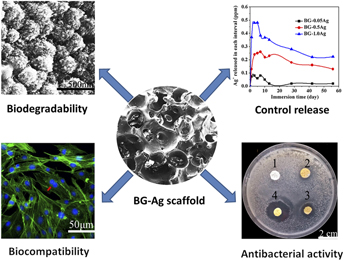Crossref Citations
This article has been cited by the following publications. This list is generated based on data provided by
Crossref.
Shuai, Cijun
Duan, Songlin
Wu, Ping
Gao, Dan
Feng, Pei
Gao, Chengde
and
Peng, Shuping
2016.
Development of bioceramic bone scaffolds by introducing triple liquid phases.
Journal of Materials Research,
Vol. 31,
Issue. 22,
p.
3498.
Galarraga‐Vinueza, M. E.
Passoni, B.
Benfatti, C. A. M.
Mesquita‐Guimarães, J.
Henriques, B.
Magini, R. S.
Fredel, M. C.
Meerbeek, B. V.
Teughels, W.
and
Souza, J. C. M.
2017.
Inhibition of multi‐species oral biofilm by bromide doped bioactive glass.
Journal of Biomedical Materials Research Part A,
Vol. 105,
Issue. 7,
p.
1994.
Zhang, Yongliang
Zhai, Dong
Xu, Mengchi
Yao, Qingqiang
Zhu, Huiying
Chang, Jiang
and
Wu, Chengtie
2017.
3D-printed bioceramic scaffolds with antibacterial and osteogenic activity.
Biofabrication,
Vol. 9,
Issue. 2,
p.
025037.
Krishnamacharyulu, N.
Jagan Mohini, G.
Sahaya Baskaran, G.
Ravi Kumar, V.
and
Veeraiah, N.
2018.
Investigation on silver doped B2O3 – SiO2 – P2O5 – Na2O – CaO bioglass system for biomedical applications.
Journal of Alloys and Compounds,
Vol. 734,
Issue. ,
p.
318.
Galarraga‐Vinueza, Maria Elisa
Mesquita‐Guimarães, Joana
Magini, Ricardo S.
Souza, Júlio C. M.
Fredel, Marcio C.
and
Boccaccini, Aldo R.
2018.
Mesoporous bioactive glass embedding propolis and cranberry antibiofilm compounds.
Journal of Biomedical Materials Research Part A,
Vol. 106,
Issue. 6,
p.
1614.
Mukhopadhyay, S.
2018.
Fundamental Biomaterials: Ceramics.
p.
129.
Kim, Hyehyun
Mondal, Sudip
Jang, Bian
Manivasagan, Panchanathan
Moorthy, Madhappan Santha
and
Oh, Junghwan
2018.
Biomimetic synthesis of metal–hydroxyapatite (Au-HAp, Ag-HAp, Au-Ag-HAp): Structural analysis, spectroscopic characterization and biomedical application.
Ceramics International,
Vol. 44,
Issue. 16,
p.
20490.
Prasad S., Sakthi
Datta, Susmit
Adarsh, Tarun
Diwan, Prerna
Annapurna, K.
Kundu, Biswanath
and
Biswas, Kaushik
2018.
Effect of boron oxide addition on structural, thermal, in vitro bioactivity and antibacterial properties of bioactive glasses in the base S53P4 composition.
Journal of Non-Crystalline Solids,
Vol. 498,
Issue. ,
p.
204.
Rahaman, M.N.
Xiao, W.
and
Huang, W.
2018.
Bioactive Glasses.
p.
285.
Balasubramanian, Preethi
Büttner, Teresa
Miguez Pacheco, Valentina
and
Boccaccini, Aldo R.
2018.
Boron-containing bioactive glasses in bone and soft tissue engineering.
Journal of the European Ceramic Society,
Vol. 38,
Issue. 3,
p.
855.
Zheng, Kai
Balasubramanian, Preethi
Paterson, Thomas E.
Stein, Rene
MacNeil, Sheila
Fiorilli, Sonia
Vitale-Brovarone, Chiara
Shepherd, Joanna
and
Boccaccini, Aldo R.
2019.
Ag modified mesoporous bioactive glass nanoparticles for enhanced antibacterial activity in 3D infected skin model.
Materials Science and Engineering: C,
Vol. 103,
Issue. ,
p.
109764.
Li, Gang
Qin, Shuhao
Zhang, Daohai
and
Liu, Xiaonan
2019.
Preparation of antibacterial degummed silk fiber/nano-hydroxyapatite/polylactic acid composite scaffold by degummed silk fiber loaded silver nanoparticles.
Nanotechnology,
Vol. 30,
Issue. 29,
p.
295101.
Naseri, Shiva
Lepry, William C.
Maisuria, Vimal B.
Tufenkji, Nathalie
and
Nazhat, Showan N.
2019.
Development and characterization of silver-doped sol-gel-derived borate glasses with anti-bacterial activity.
Journal of Non-Crystalline Solids,
Vol. 505,
Issue. ,
p.
438.
Li, Gang
Qin, Shuhao
Liu, Xiaonan
Zhang, Daohai
and
He, Min
2019.
Structure and properties of nano-hydroxyapatite/poly(butylene succinate) porous scaffold for bone tissue engineering prepared by using ethanol as porogen.
Journal of Biomaterials Applications,
Vol. 33,
Issue. 6,
p.
776.
Li, Gang
Zhang, Daohai
and
Qin, Shuhao
2019.
Preparation and Performance of Antibacterial Polyvinyl Alcohol/Polyethylene Glycol/Chitosan Hydrogels Containing Silver Chloride Nanoparticles via One-step Method.
Nanomaterials,
Vol. 9,
Issue. 7,
p.
972.
Lin, Bocai
Hu, Hongxing
Deng, Zhengwei
Pang, Libin
Jiang, Haizhen
Wang, Deping
Li, Jiusheng
Liu, Zhongtang
Wang, Hui
and
Zeng, Xiangqiong
2020.
Novel bioactive glass cross-linked PVA hydrogel with enhanced chondrogenesis properties and application in mice chondrocytes for cartilage repair.
Journal of Non-Crystalline Solids,
Vol. 529,
Issue. ,
p.
119594.
Lepry, William C.
and
Nazhat, Showan N.
2020.
The anomaly in bioactive sol–gel borate glasses.
Materials Advances,
Vol. 1,
Issue. 5,
p.
1371.
Xu, Yong
Liu, Wei
Zhang, Gangqiang
Li, Zhipeng
Hu, Hongxing
Wang, Chenchen
Zeng, Xiangqiong
Zhao, Shichang
Zhang, Yadong
and
Ren, Tianhui
2020.
Friction stability and cellular behaviors on laser textured Ti–6Al–4V alloy implants with bioinspired micro-overlapping structures.
Journal of the Mechanical Behavior of Biomedical Materials,
Vol. 109,
Issue. ,
p.
103823.
Chang, Yuchen
Zhao, Renliang
Wang, Hui
Pang, Libin
Ding, Jingxin
Shen, Yifan
Guo, Yanjie
and
Wang, Deping
2020.
A novel injectable whitlockite-containing borosilicate bioactive glass cement for bone repair.
Journal of Non-Crystalline Solids,
Vol. 547,
Issue. ,
p.
120291.
Eivazzadeh‐Keihan, Reza
Bahojb Noruzi, Ehsan
Khanmohammadi Chenab, Karim
Jafari, Amir
Radinekiyan, Fateme
Hashemi, Seyed Masoud
Ahmadpour, Farnoush
Behboudi, Ali
Mosafer, Jafar
Mokhtarzadeh, Ahad
Maleki, Ali
and
Hamblin, Michael R.
2020.
Metal‐based nanoparticles for bone tissue engineering.
Journal of Tissue Engineering and Regenerative Medicine,
Vol. 14,
Issue. 12,
p.
1687.
